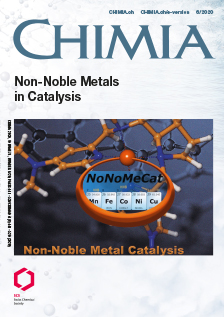On the Ability of Nickel Complexes Derived from Tripodal Aminopyridine Ligands to Catalyze Arene Hydroxylations
DOI:
https://doi.org/10.2533/chimia.2020.489PMID:
32560755Keywords:
Aromatic C-H oxidation, Fluorinated solvents, Hydrogen peroxide, Nickel complexes, PhenolsAbstract
The development of catalysts for the selective hydroxylation of aromatic C–H bonds is an essential challenge in current chemical research. The accomplishment of this goal requires the discovery of powerful metal-based oxidizing species capable of hydroxylating inert aromatic bonds in a selective manner, avoiding the generation of non-selective oxygen-centered radicals. Herein we show an investigation on the ability of nickel(ii) complexes supported by tripodal tetradentate aminopyridine ligands to catalyze the direct hydroxylation of benzene to phenol with H2O2 as oxidant. We have found that modifications on the ligand structure of the nickel complex do not translate into different reactivity, which differs from previous findings for nickel-based arene hydroxylations. Besides, several nickel(ii) salts have been found to be effective in the oxidation of aromatic C–H bonds. The use of fluorinated alcohols as solvent has been found to result in an increase in phenol yield; however, showing no more than two turn-overs per nickel. These findings raise questions on the nature of the oxidizing species responsible for the arene hydroxylation reaction.
Downloads
Published
Issue
Section
License
Copyright (c) 2020 Eduard Masferrer-Rius, Raoul M. Hopman, Jishai van der Kleij, Martin Lutz, Robertus J. M. Klein Gebbink

This work is licensed under a Creative Commons Attribution-NonCommercial 4.0 International License.







